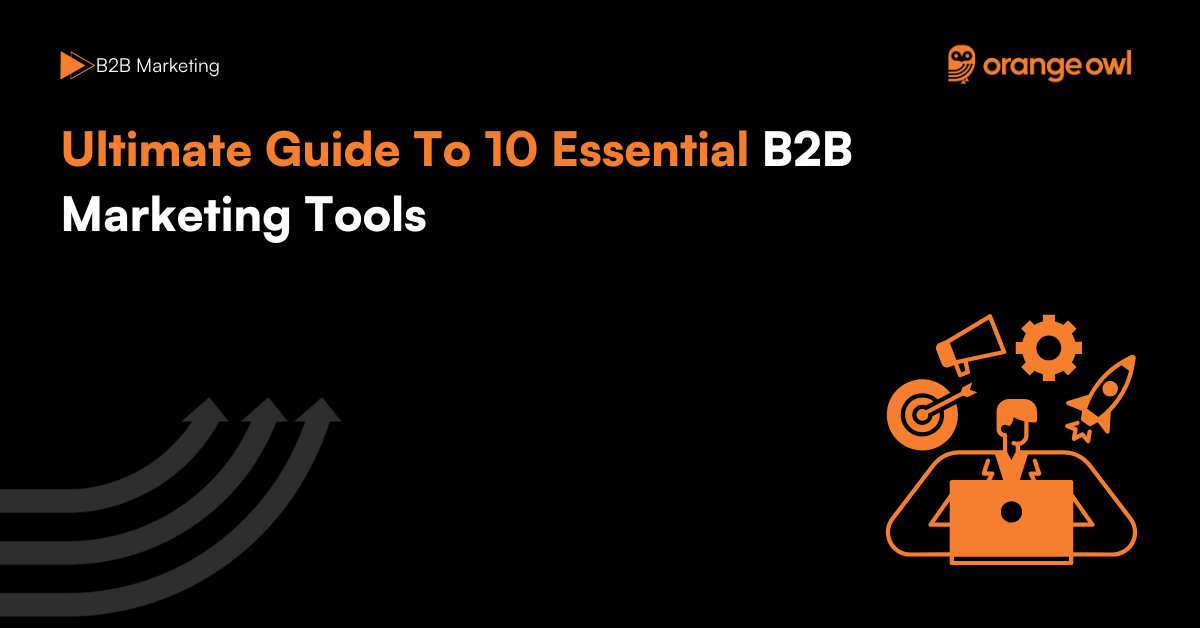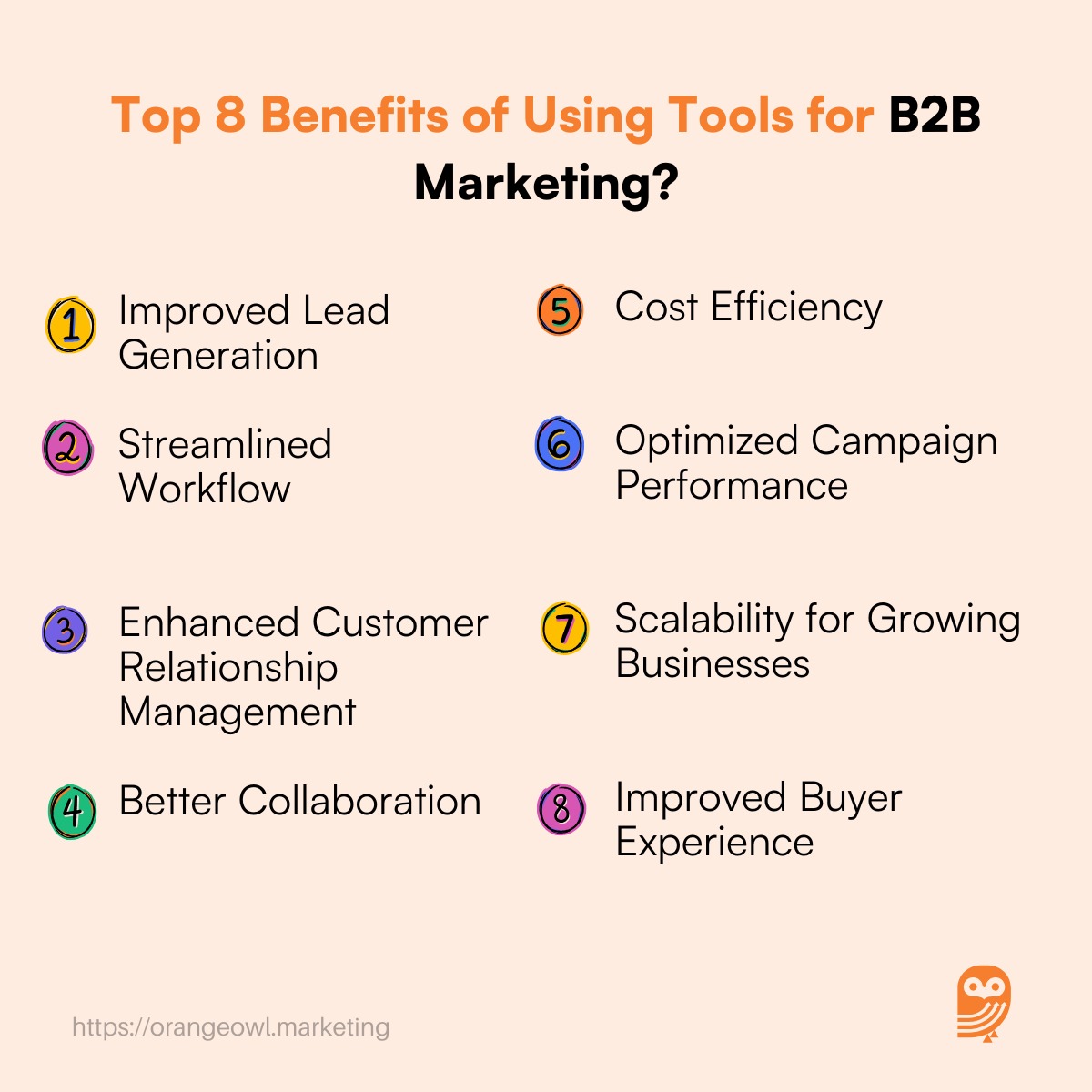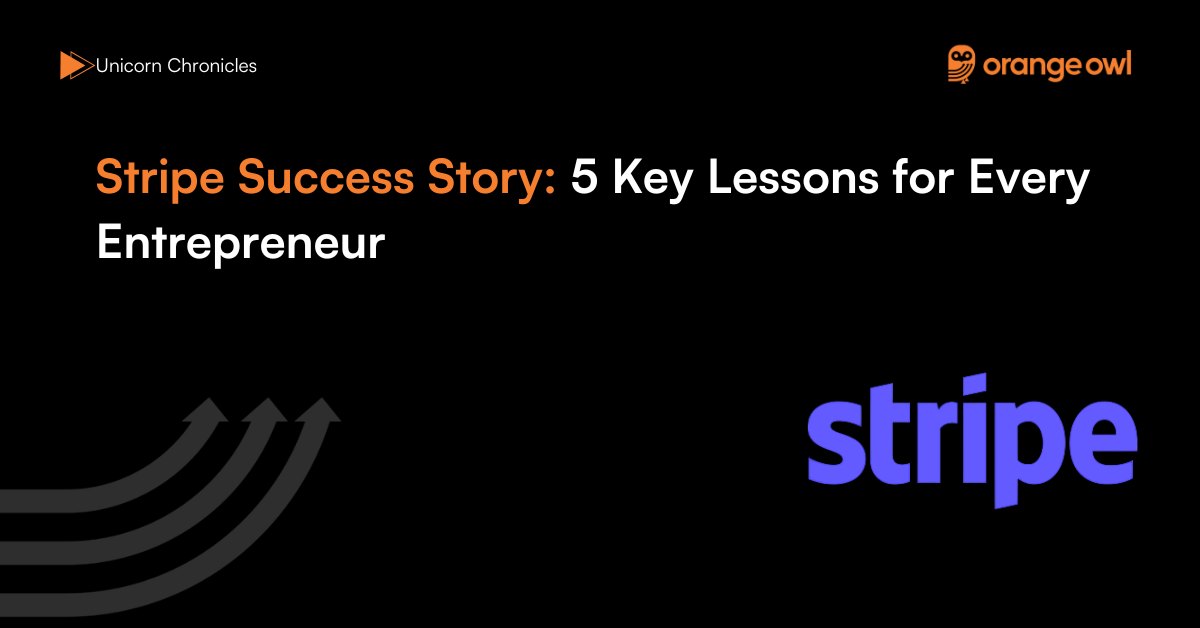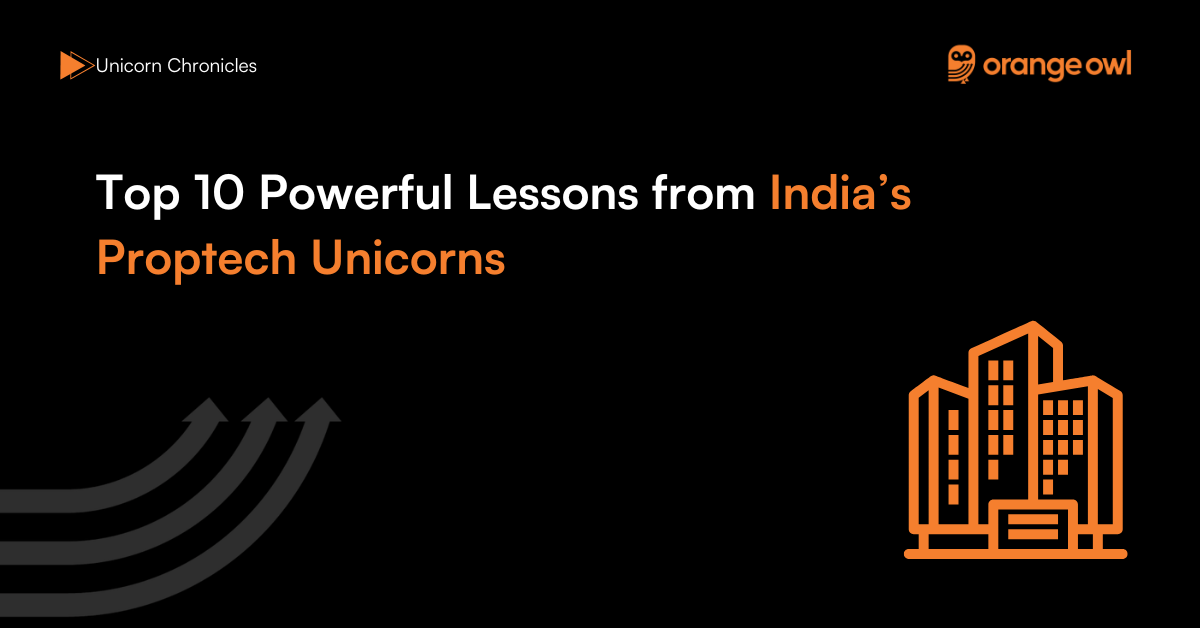The Ultimate Guide to Top 10 Essential B2B Marketing Tools
Vivek Goel
November 27, 2024

Table of Contents
Introduction
In today’s dynamic B2B marketing landscape, simply having a strong strategy is no longer enough. The complexity of reaching decision-makers, nurturing leads, and measuring results has increased exponentially. To navigate this, having the right set of tools is indispensable.
From automating mundane tasks to delivering actionable insights, these tools empower B2B marketers to focus on what truly matters—creating value for customers and driving business growth. Whether you’re running email campaigns, analyzing website traffic, or engaging high-value prospects on social media, the tools you choose can make or break your marketing efforts.
This comprehensive guide dives deep into the 10 essential B2B marketing tools every B2B marketer needs, backed by real-world examples and data to show how these platforms can enhance your campaigns and drive results. By the end, you’ll have a clear roadmap for building a toolset that not only meets your marketing needs but also propels your business forward in a competitive market.
Why Use These Tools Essential in B2B Marketing?
In the B2B space, marketing is more complex than in the B2C realm. Businesses must cater to a longer sales cycle, target multiple decision-makers, and deliver highly personalized messaging. These challenges make it essential to have tools that streamline operations, enhance decision-making, and optimize campaigns for better results. Here’s why these tools are indispensable:
- Efficiency and Automation: Many B2B marketing activities, such as lead nurturing, data management, and campaign execution, are repetitive. Tools like CRM and marketing automation platforms handle these tasks seamlessly, freeing up time for strategic activities.
- Data-Driven Insights: Analytics and SEO tools provide real-time insights into audience behavior, campaign performance, and market trends. This data helps marketers fine-tune strategies, ensuring better ROI.
- Enhanced Personalization: Tools like ABM platforms and email marketing software enable businesses to tailor their outreach efforts. Personalization improves engagement, fosters trust, and increases the likelihood of conversions.
- Scalability: As businesses grow, their marketing needs expand. Tools like CMS and collaboration platforms provide scalability, allowing companies to manage larger teams, more extensive content, and bigger campaigns.
- Integration Across Channels: With multiple touchpoints in B2B marketing, tools like social media management and CRM ensure all channels are synchronized, delivering a consistent brand experience.
10 Essential B2B Marketing Tools Every B2B Marketer Should Have
In the ever-evolving world of B2B marketing, the right tools can make all the difference in executing impactful campaigns, generating high-quality leads, and achieving your business goals. This blog provides a detailed overview of 10 essential tools every B2B marketer should have in their arsenal, complete with real-world examples and data-driven insights.
1. CRM Software: Salesforce, HubSpot, and Zoho CRM
These platforms centralize customer data, enabling businesses to streamline communication and build long-term relationships.
Salesforce: Known for its scalability and robust integrations, Salesforce offers AI-powered insights and automation tools. It’s ideal for enterprises handling vast amounts of data.
HubSpot: A more user-friendly option, HubSpot integrates CRM with marketing, sales, and customer service features, making it suitable for small to mid-sized businesses.
Zoho CRM: A cost-effective alternative, Zoho CRM is highly customizable and integrates with other Zoho applications for businesses looking to stay within budget.
How It’s Used: These platforms are used to store and manage customer data, track interactions, and automate sales processes. They help in segmenting customers, forecasting sales, and creating personalized marketing campaigns.
Tips:
- Integrate your CRM with email marketing tools and analytics platforms for a seamless data flow.
- Regularly update customer information to ensure accurate reporting and targeted campaigns.
2. Marketing Automation Platforms: Marketo Engage, Pardot, and ActiveCampaign
These tools automate repetitive tasks, saving time and improving efficiency.
Marketo Engage: Perfect for enterprises, Marketo specializes in lead management and email automation, with advanced AI tools for personalized campaigns.
Pardot: As part of Salesforce, Pardot provides seamless integration with CRM for B2B marketers focused on nurturing leads and tracking ROI.
ActiveCampaign: Affordable and intuitive, ActiveCampaign combines email automation, CRM, and marketing workflows for smaller teams.
How It’s Used: Automates email campaigns, lead scoring, customer segmentation, and social media scheduling. These tools help nurture leads and streamline marketing workflows.
Tips:
- Use lead scoring to prioritize your most engaged prospects for follow-up.
- Test automation workflows regularly to ensure smooth functioning and identify potential gaps.
3. Content Management Systems (CMS): WordPress, Drupal, and Sitecore
CMS platforms make it easy to manage websites and execute content strategies.
WordPress: The most popular CMS, WordPress offers endless customization options, plugins, and themes, making it suitable for businesses of all sizes.
Drupal: Known for its security and flexibility, Drupal is preferred by large organizations handling complex data structures.
Sitecore: A premium CMS designed for enterprises, Sitecore focuses on delivering personalized customer experiences at scale.
How It’s Used: CMS platforms are used to create, edit, and manage website content without requiring advanced technical skills. They also support integrations for SEO, analytics, and e-commerce.
Tips:
Use plugins to optimize page load speed and improve SEO rankings.
Regularly update your CMS and plugins to prevent security vulnerabilities.
4. Email Marketing Tools: Mailchimp, Constant Contact, and SendGrid
Email remains a cornerstone of B2B marketing, and these tools simplify its management.
Mailchimp: Renowned for its ease of use, Mailchimp offers advanced segmentation and A/B testing features, suitable for businesses of all sizes.
Constant Contact: Ideal for small businesses, it provides a drag-and-drop editor and detailed analytics for easy campaign optimization.
SendGrid: Known for its robust API, SendGrid is perfect for businesses sending high volumes of transactional or promotional emails.
How It’s Used: These tools enable businesses to design visually appealing emails, schedule campaigns, and analyze metrics like open rates and click-through rates.
Tips:
- Segment your email list based on industry, behavior, or demographics for higher engagement.
- A/B test email subject lines and content to refine your messaging strategy.
5. Analytics and Reporting Tools: Google Analytics, Adobe Analytics, and Tableau
Understanding data is critical for refining marketing strategies.
Google Analytics: A free tool offering deep insights into website traffic, user behavior, and conversion tracking.
Adobe Analytics: Suitable for enterprises, it provides real-time data, advanced segmentation, and predictive analytics.
Tableau: Known for its visual dashboards, Tableau simplifies data storytelling and enables cross-functional collaboration.
How It’s Used: Provide insights into website traffic, customer behavior, campaign performance, and ROI. They help identify trends and refine marketing strategies.
Tips:
- Set up custom dashboards to track KPIs relevant to your campaigns.
- Integrate analytics tools with your CRM to gain a holistic view of customer journeys.
6. Search Engine Optimization (SEO) Tools: SEMrush, Ahrefs, and Moz
SEO tools help businesses improve their online visibility and attract quality leads.
SEMrush: Comprehensive and user-friendly, SEMrush excels in keyword research, competitor analysis, and PPC campaign optimization.
Ahrefs: With powerful backlink tracking and content gap analysis, Ahrefs is a favorite among content marketers.
Moz: Known for its intuitive interface, Moz offers excellent tools for site audits, SERP tracking, and domain authority analysis.
How It’s Used: These tools are used for keyword research, competitor analysis, backlink tracking, and content optimization to improve search engine rankings.
Tips:
- Regularly conduct site audits to fix technical issues affecting SEO performance.
- Focus on creating high-quality content around long-tail keywords for better ranking opportunities.
7. Social Media Marketing Tools: Hootsuite, Buffer, and Sprout Social
These tools simplify content scheduling, engagement, and analytics for social platforms.
Hootsuite: A versatile tool for managing multiple social media accounts, offering post scheduling and performance analytics.
Buffer: Focused on simplicity, Buffer is great for small teams looking to maintain an active social media presence.
Sprout Social: Known for its in-depth analytics and reporting, Sprout Social is ideal for businesses focused on data-driven social strategies.
How It’s Used: Manage multiple social media accounts, schedule posts, monitor engagement, and analyze performance metrics from one platform.
Tips:
- Use analytics insights to determine the best times to post content.
- Monitor brand mentions and engage with your audience promptly to build trust.
8. Webinar and Virtual Event Platforms: Zoom, ON24, and BigMarker
Webinars are essential for engaging and educating potential buyers.
Zoom: Widely used for its simplicity, Zoom is ideal for hosting webinars with basic interactive features.
ON24: Designed for professional B2B webinars, ON24 offers features like detailed analytics, lead scoring, and audience engagement tools.
BigMarker: A robust platform for virtual events, BigMarker supports integrations with marketing tools to ensure a seamless attendee experience.
How It’s Used: Host live webinars, virtual events, and on-demand sessions for lead generation, customer education, and brand building.
Tips:
- Use interactive features like polls and Q&A to engage participants and gather insights.
- Promote webinars across channels to maximize attendance and reach
9. Collaboration Tools: Slack, Trello, and Asana
Efficient teamwork is key to executing successful campaigns.
Slack: A communication platform that organizes conversations into channels, enhancing collaboration within and across teams.
Trello: Known for its visual interface, Trello is perfect for managing tasks, content calendars, and project workflows.
Asana: A more feature-rich alternative to Trello, Asana is ideal for larger teams managing complex marketing projects.
How It’s Used: Facilitate communication, organize tasks, and streamline project management across teams. These tools enhance coordination and ensure timely completion of campaigns.
Tips:
- Create specific channels or boards for different campaigns to avoid clutter.
- Use automation features to assign tasks, set deadlines, and send reminders.
10. Account-Based Marketing (ABM) Tools: Demandbase, Terminus, and 6sense
ABM tools focus on targeting high-value accounts with personalized strategies.
Demandbase: Known for its AI-driven insights and detailed account tracking, Demandbase aligns sales and marketing for maximum impact.
Terminus: Terminus specializes in multi-channel engagement, enabling personalized outreach through ads, email, and web campaigns.
6sense: Using predictive analytics, 6sense identifies in-market accounts and recommends the best approaches for conversion.
How It’s Used: Target high-value accounts with tailored campaigns, using insights from these tools to deliver personalized messaging and maximize ROI.
Tips:
- Combine ABM tools with analytics and CRM for a unified approach to targeting and tracking key accounts.
- Regularly update account data to keep campaigns relevant and aligned with customer needs.
Top 8 Benefits of using Tools for B2B Marketing?
Adopting the right tools brings a host of benefits that directly impact a company’s marketing success and bottom line. Let’s explore these advantages in detail:
1. Improved Lead Generation
Marketing tools help identify high-quality leads by analyzing behavior, demographics, and engagement levels. CRM platforms, for instance, store and segment leads effectively, enabling targeted campaigns. Studies show that businesses using lead management tools achieve a 9.3% higher sales quota attainment rate compared to those that don’t.
2. Streamlined Workflow
Automation platforms reduce manual work, allowing teams to focus on creative and strategic tasks. This leads to increased productivity and faster execution of campaigns. For example, a company using HubSpot for marketing automation can achieve 15% faster campaign deployment.

3. Enhanced Customer Relationship Management
CRM tools create a unified repository of customer data, enabling better understanding and stronger relationships. Research indicates that businesses using CRM see a 27% increase in customer retention rates, which is critical for long-term profitability in B2B markets.
4. Optimized Campaign Performance
Analytics tools provide actionable insights, helping marketers identify what works and what doesn’t. By leveraging data from Google Analytics or Tableau, marketers can optimize their campaigns to maximize engagement and conversions, leading to a 20% increase in marketing ROI on average.
5. Cost Efficiency
B2B tools help reduce wastage by targeting the right audience and automating repetitive tasks. For instance, social media management tools allow companies to schedule and post content efficiently across multiple platforms, saving time and resources while increasing engagement.
6. Better Collaboration
Tools like Trello and Slack improve communication and coordination among teams. Marketing and sales alignment—a common issue in B2B—becomes achievable, leading to a 36% higher customer retention rate when both teams work cohesively.
7. Scalability for Growing Businesses
As B2B companies expand, their marketing needs become more complex. Tools like CMS and ABM platforms are designed to scale with businesses, ensuring continued success. For example, integrating a CMS with ABM can support larger audiences while maintaining personalized engagement.
8. Improved Buyer Experience
Buyers today expect seamless and personalized experiences. Marketing tools enable companies to provide consistent messaging and customized solutions across various stages of the buyer’s journey, enhancing trust and satisfaction. A study by Salesforce reveals that 84% of B2B buyers are more likely to buy from companies that understand their goals.
Conclusion
In the ever-evolving world of B2B marketing, staying ahead requires more than creativity and persistence—it demands leveraging the right technology to execute smarter, faster, and more effectively. The tools discussed in this blog are not just add-ons; they are essential components of a modern marketer’s arsenal, enabling better decision-making, streamlined operations, and meaningful engagement with target audiences.
However, the key to success lies not just in adopting these tools but in integrating them effectively into your marketing workflow. For instance, combining a CRM with marketing automation and analytics tools can provide a 360-degree view of your customer journey, while ABM platforms can enhance targeting for your most valuable accounts.
Remember, the marketing landscape is constantly changing, and staying adaptable is crucial. Regularly evaluating your tools and upgrading as needed will ensure you remain competitive and continue to deliver exceptional results.
Start small, experiment, and scale as your needs grow. Armed with these 10 tools, you’re not just ready to compete—you’re set to lead. Want to take it a step further? Collaborating with Orange Owl can make your journey even smoother. With our expertise in B2B marketing strategies and hands-on experience with these tools, we’ll help you tailor a marketing toolkit that aligns perfectly with your business goals. Together, we can optimize your efforts, streamline your processes, and ensure impactful results.
What will your first step be toward optimizing your B2B marketing toolkit? Let us know in the comments, or connect with Orange Owl today to simplify your path to success!
Frequently Asked Questions (FAQs) on Essential Tools For B2B Marketing Strategy
To determine the most suitable tools, start by assessing your business’s marketing goals, target audience, and pain points. If you’re struggling with lead generation, consider tools like LinkedIn Sales Navigator or HubSpot. For content marketing, platforms like Semrush or Grammarly may be more beneficial. Create a checklist of required features and evaluate tools through free trials or demos before committing to a purchase.
Key features include robust lead management, automated email campaigns, analytics dashboards, and integration capabilities with CRM and social media platforms. Additionally, look for advanced features like behavioral tracking, A/B testing, and AI-driven insights that can enhance campaign personalization and effectiveness.
Many advanced tools have tiered pricing models, including free or affordable entry-level plans tailored for small businesses. For example, HubSpot offers free CRM software with basic marketing automation features, while tools like Mailchimp and Canva have cost-effective packages. By starting with budget-friendly tools and scaling as you grow, small businesses can effectively use these solutions without overspending.
Marketing tools like CRM systems, such as Salesforce or Zoho, unify data from both sales and marketing, providing a single source of truth. This alignment ensures that marketing efforts are targeted toward qualified leads while sales teams receive valuable insights to close deals faster. Collaboration features, such as shared dashboards and real-time updates, further promote synergy between the teams.
Important metrics include lead conversion rates, customer acquisition costs, and lifetime value. Website analytics tools like Google Analytics can provide insights into traffic sources, bounce rates, and user behavior. For campaign performance, monitor email open rates, click-through rates, and ROI. These metrics help you identify which strategies are working and where adjustments are needed.
Social media tools like Hootsuite and Buffer are highly relevant for B2B marketing, as they simplify content scheduling, engagement tracking, and performance analysis. These platforms allow businesses to establish thought leadership, engage with potential leads, and showcase expertise through platforms like LinkedIn, where most B2B decision-makers are active.
Collaboration tools streamline communication and task management within marketing teams. Slack enables instant messaging, file sharing, and integration with marketing tools like Google Drive, while Trello organizes tasks using visual boards. This minimizes delays, ensures accountability, and helps track the progress of campaigns in real-time.
ABM platforms, such as Demandbase or Terminus, are ideal for businesses focusing on high-value accounts or niche markets. These platforms help create personalized campaigns tailored to specific clients, increasing the likelihood of conversion. While not every business may need ABM initially, those looking to target specific industries or large clients can benefit significantly from its targeted approach.
Webinar platforms like Zoom, Webex, or GoToWebinar provide a direct channel to connect with your audience, showcase expertise, and offer value-driven content. Webinars help educate potential buyers about your product or service, create networking opportunities, and generate highly qualified leads. Post-event follow-ups can further nurture leads down the sales funnel.
Staying updated requires consistent learning and adaptation. Subscribe to industry newsletters, attend webinars or workshops, and follow thought leaders on LinkedIn. Additionally, joining marketing communities or forums can provide first-hand insights into emerging tools and practices. Experimenting with free trials of new tools can also help marketers stay ahead of the curve.


